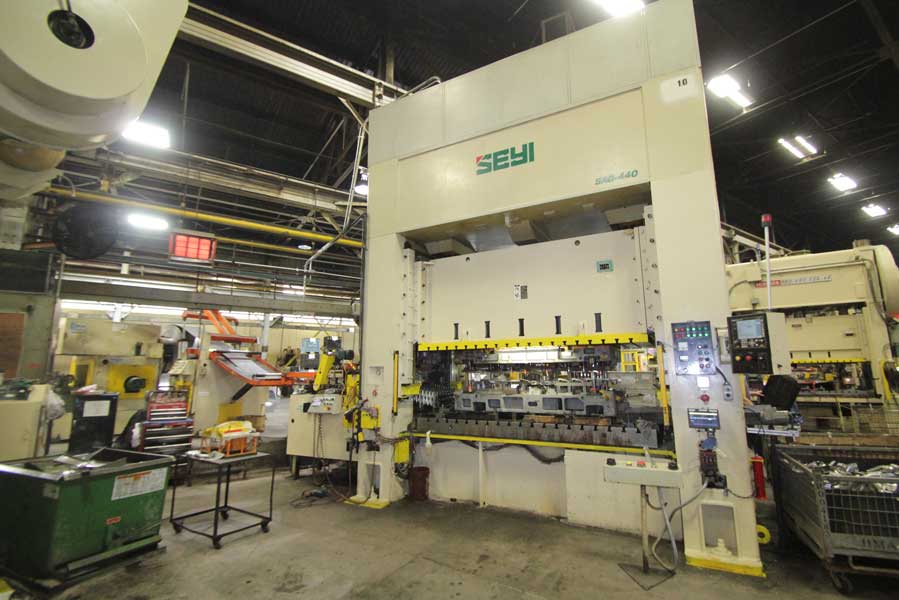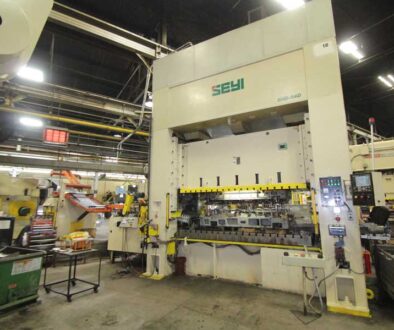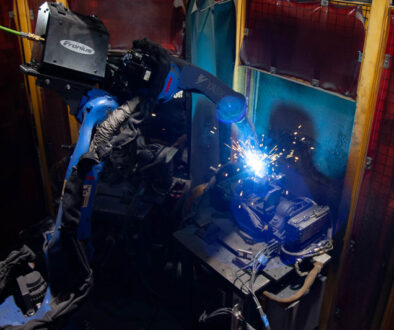Mechanical Presses: Conventional Metal Stamping Presses Explained

Mechanical presses are preferred in many of today’s metal stamping applications for the production speed and simplicity the machines offer.
Compared to hydraulic presses, conventional mechanical stamping presses are easier to set up and operate, easier to maintain, while also offering a generally higher stroke speed to accommodate high-volume manufacturing requirements.
While hydraulic presses can offer a bit more versatility, mechanical presses are often the ideal choice for producing custom stamped parts that are complex but do not have very deep draws. From automotive parts and panels to HVAC and appliance stampings, mechanical presses are efficiently utilized across many industries and commercial applications.
At SPI, our metal stamping services utilize a wide range of highly capable mechanical presses, including transfer presses and progressive metal stamping systems. In this article, we break down the basic anatomy of the mechanical press, as well as some of its advantages the configuration offers over its hydraulic and servo-driven counterparts.
How Mechanical Stamping Presses Work – Put Simply Suppliers:
To illustrate the concept simply: mechanical presses use an electric motor to generate kinetic energy, which is stored in a massive mechanical flywheel.
For visualization purposes, it’s not dissimilar to the way a typical car engine generates torque at its crankshaft flywheel – except in that case power is generated from pistons above undergoing the combustion process. With a mechanical press, that energy is fed into the system externally, and the flywheel in turn drives the connected punch-press system.
The Basic Anatomy of a Mechanical Stamping Press:
- Frame – The press is built on a sturdy frame that provides structural support and stability.
- Bed – The bed is a flat surface where the metal workpiece rests during the stamping process. It typically includes a die cushion or bolster plate to support the die.
- Die – The die is a specialized tool consisting of upper and lower sections. It is designed to shape and cut the metal workpiece into the desired form. The die is mounted onto the press, with the upper section attached to the ram and the lower section fixed to the bed.
- Ram – The ram is the moving part of the press that applies the necessary force to the metal workpiece. It is driven by a mechanical mechanism such as a crankshaft or eccentric gear. The ram moves up and down in a vertical motion.
- Clutch and Brake – The clutch and brake system control the movement of the ram. When engaged, the clutch connects the ram to the drive mechanism, allowing it to move. The brake system provides stopping power to halt the movement of the ram.
- Drive Mechanism – The drive mechanism converts rotary motion into linear motion to drive the ram. It is typically powered by an electric motor and consists of components like flywheels, gears, and crankshafts.
- Feed System – The feed system supplies coil stock or blanks to the stamping area, positioning them accurately for each cycle. It may involve rollers, grippers, or other mechanisms to advance the material.
- Control System – Modern presses use digital control systems to safely and accurately regulate various aspects of the stamping press. The stroke speed, timing, and force applied during operation are all precisely monitored and controlled.
The Basic Operation of a Mechanical Stamping Press:
When a stamping operation begins, the press operator feeds a metal workpiece into the press and positions it correctly. The control system initiates the stamping cycle, activating the drive mechanism. The ram descends under pressure, pushing the upper die section into contact with the workpiece. This force cuts and shapes the metal according to the design of the die.
After completing the stamping process, the feed system then advances the coil or blank into position for the subsequent cycle. This process continues in a continuous motion until the work order is complete.
Want to see what a mechanical press in action looks like? Check out SPI’s Gallery for a selection of our custom stamped parts and press equipment.
60+ Years of Quality American Metal Stamping Services
SPI has provided our customers with quality metal stamping services since 1962. Proudly based out of Gadsden, Alabama, our 124,000 sq.-ft facility has grown into one of the nation’s leading sources of custom U.S.A.-made metal stampings and weldments. Our company is a leading provider for Tier 1 and Tier 2 automotive stampings, as well as utility vehicle (UTV) and all-terrain vehicle (ATV) parts, HVAC components, consumer appliances, and agricultural equipment


